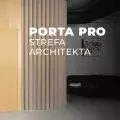In today's society, activity is 24 hours a day, 7 days a week, and people are increasingly leading lifestyles that are disconnected from the rhythms of the natural world. This means that lighting is needed during the hours of darkness so that people can go about their business safely, whether it's crossing a park to get home after a night shift or emergency duties from the services.
The need for safety is the overriding need placed on lighting. Meeting this criterion can be considered on two levels. On the one hand, lighting facilitates orientation in the area, allowing free and safe movement after dark. It also eliminates anonymity and provides the possibility of recognizing faces on surveillance. In addition, in an illuminated area, the risk of attacks and vandalism decreases. On the other hand, lighting affects the user's comfort and sense of security, how he or she perceives and sees a given space, whether he or she finds it attractive, which is of great importance, if only for the development of urban tourism.
© Zumtobel
At the same time, awareness of light pollution is growing. According to the 2016 study "New World Atlas of Artificial Night Sky Brightness". 80% of the world's population lives under a sky with a glow, while in the United States and Europe 99% of the population cannot experience a "natural night." (Falchi F. et al., 2016)
The International Dark-Sky Association (IDA) has begun quantifying the situation in a series of statistics published online. The association explains:
Worldwide,we spend at least $50 billion in energy costs every year to produce light that escapes into space. (International Dark-Sky Association, 2022)
It is also claimed that light emissions from the continents account for 246,238 gigawatt-hours of energy, or 1% of global emissions, the equivalent of 38 million miles driven by vehicles (Sanchez de Miguel A. et al., 2021), and that, according to estimates, 35% of outdoor light is wasted.
So how do we reconcile the need for effective and efficient lighting with respect for the environment and the need to mitigate its negative effects?
Balance wildlife and human needs. Learn about nighttune technology that provides a sense of security and protects the nocturnal ecosystem
The Thorn brand has been developing efficient, energy-saving and environmentally friendly solutions for many years. One such solution is NightTune, a system that automatically adjusts the light level emitted by a luminaire and its color temperature according to the exact time of night, traffic volume and is implemented according to specific design and application needs. It works by mixing light from warm and neutral LEDs and dimming or brightening the two groups of LEDs separately. Color temperatures from warm (2,200 K) to moderate (3,000 K) can be achieved at different brightness levels.
© Zumtobel
By introducing a system using NightTune technology and the UrbaSens control system, it is possible to reduce energy consumption by up to 80%, without sparing other lighting functions: providing security, creating the identity of a place, displaying interesting architectural forms.
Instead of lighting fixtures operating at full output for hours of darkness, they can be dimmed when traffic and pedestrian volumes decrease. This solution brings economic and environmental benefits.
For detailed information on NightTune technology, see the white paper prepared by the Thorn brand, from which you can learn, among other things, what light pollution is and what effects it can have, how light pollution affects human mental health and the lives of nocturnal animals, and what solutions can be implemented to protect the nighttime ecosystem.
For more information, visit the company's THORN Lighting page on the A&B portal.





















